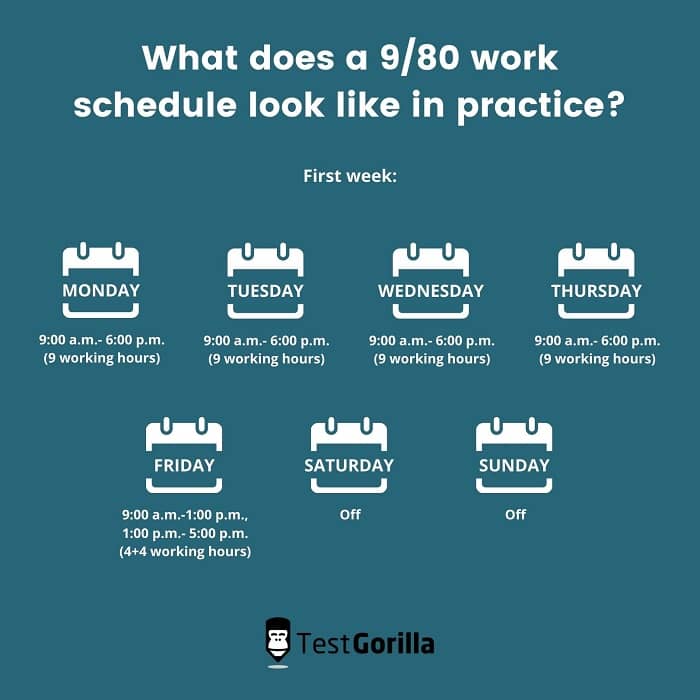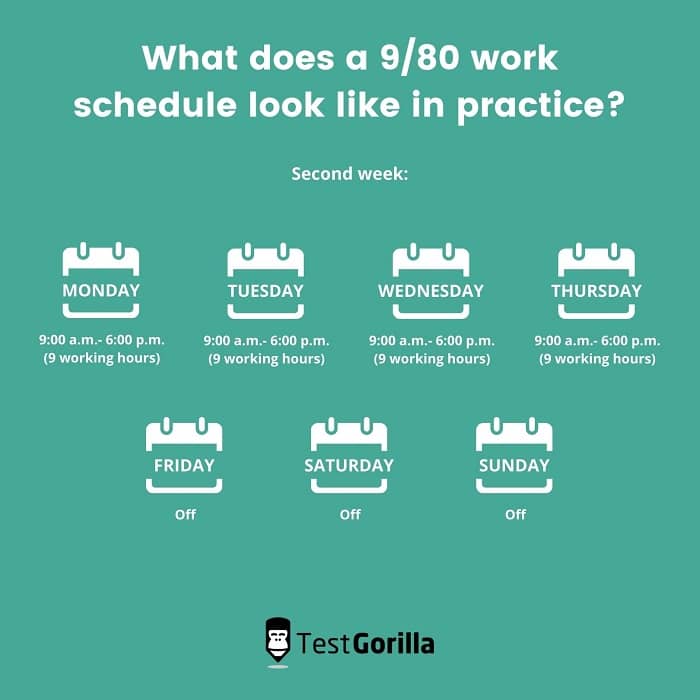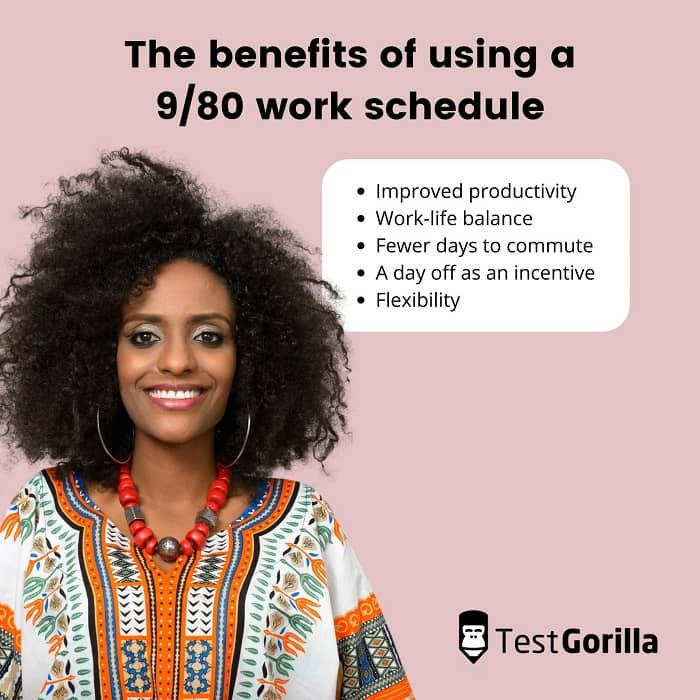COVID-19 disrupted many operational norms in the workplace, one of them being the working schedule. In many workplaces, employees no longer come to work at a fixed time every morning and leave at a fixed time every evening.
Now, employees have offline, online (remote), and hybrid options. All of these aim to do the same thing: increase productivity while maximizing employees’ autonomy, satisfaction, and work-life balance.
In turn, companies want to create greater engagement in their workforce, alongside increased productivity and loyalty to their brand.
Employees want a better work-life balance, and companies are trying to give it to them. This has resulted in a lot of experiments in the workplace, including implementing a 9/80 work schedule.
So, let’s see what it looks like in practice, the benefits and challenges of a 9/80 work schedule, and how to start using one in your organization.
Table of contents
What is a compressed 9/80 work schedule?
Instead of making employees follow a rigid 9-5 schedule, some companies have started adopting an alternative calendar that could work better for their employees — a 9/80 work calendar.
A 9/80 schedule is a flexible work schedule that divides work into two-week slots. In the first week, employees work an additional hour (for a total of nine hours) each day from Monday to Thursday. On Friday, they work the normal eight hours.
When you combine the hours of the first four days (working nine hours a day from Monday to Thursday adds up to 36 hours of work) and add the first four hours of work on Friday, you get 40 working hours — the regular number of hours worked weekly by a full-time employee.
The last four hours of work on that Friday actually start the work for the following week. So when your employees get back to work the next Monday (the second week), they will already have worked for four hours that week.
Again, they will work for nine hours from Monday to Thursday. When combined with the four hours worked on the previous Friday, this adds up to a 40-hour week. But this week, they take Friday off since they have already worked for 40 hours.
This cycle starts again the next Monday. In other words, by following this schedule and adding only one more working hour per day from Monday to Thursday, you’ll give your employees one Friday off work every two weeks.
Taking into consideration that the average year has around 52 weeks, that means that your employees will get about 26 Fridays off annually. The employees will have around two three-day weekends every single month. And this is on top of the remaining healthcare benefits, holidays, and other benefits and perks they receive from their employment contract.
What does a 9/80 work rotation look like in practice?
Let’s see an example of what a 9/80 rotation looks like in practice.
So, your employees come in on Monday to work at 9:00 a.m., and instead of leaving that day at 5:00 p.m, they leave at 6:00 p.m.
First Week:
Monday — 9:00 a.m.- 6:00 p.m. (9 working hours)
Tuesday — 9:00 a.m.- 6:00 p.m. (9 working hours)
Wednesday — 9:00 a.m.- 6:00 p.m. (9 working hours)
Thursday — 9:00 a.m.- 6:00 p.m. (9 working hours)
Friday — 9:00 a.m.-1:00 p.m., 1:00 p.m.- 5:00 p.m. (4+4 working hours)
Saturday — off
Sunday — off
Remember that on Friday, the first week officially ends after four working hours, and the remaining four hours of that day are considered the hours that start the next week.
Second Week:
Monday — 9:00 a.m.- 6:00 p.m. (9 working hours)
Tuesday — 9:00 a.m.- 6:00 p.m. (9 working hours)
Wednesday — 9:00 a.m.- 6:00 p.m. (9 working hours)
Thursday — 9:00 a.m.- 6:00 p.m. (9 working hours)
Friday — off
Saturday — off
Sunday — off
This is just one example of a 9/80 schedule, and you don’t have to follow it to the letter. You can start earlier, such as at 7:00 a.m. or 8:00 a.m., depending on your industry.
The best insights on HR and recruitment, delivered to your inbox.
Biweekly updates. No spam. Unsubscribe any time.
The benefits of using a 9/80 work schedule
There are multiple benefits of using a 9/80 work schedule. Let’s look into the ones that provide the biggest return on investment.
Improved productivity
An interesting case of a company increasing its productivity while using a 9/80 work schedule comes to us from the Microsoft branch in Japan.
Microsoft Japan reported that their sales increased by about 40%. And that’s not all — they also reduced their electricity consumption by 23% and paper printing by 59%.
When employees have a higher level of autonomy in their work, they bring more energy to their workplace and, with it, better results. Employees need to feel like they’re in control of what they’re doing, how they’re doing it, and when they’re doing it. The more companies can provide that kind of environment, the more productive their employees will be.
Having an extra day off every other Friday can provide an employee instant gratification and serve as a checkpoint during those two weeks. The employee will feel like if they accomplish all of their tasks on time and with excellence, they will be rewarded with a prolonged, three-day weekend every other week — it’s a great incentive.
This, in turn, results in more work getting done every single day, as employees look forward to their reward in the form of a day off.
Work-life balance
Work-life balance is important to prevent your employees from burning out. Burnout can lead to decreased employee performance, more sick days, and physical and emotional exhaustion.
Employees can spend that additional day off catching up with their families, going on family trips, getting health checkups, etc. An additional day off works wonders for employees’ work-life balance.
Check out these work-life balance statistics for more insights.
Fewer days to commute
Did you know that the average US employee spends 27.6 minutes traveling to work? And that’s just one way. According to the US Census Bureau, this is a 10% increase from 2006.
The average commuter spends almost an hour each day going to and from work, and for some employees, the commute can be even longer if they ride on trains and buses.
With a 9/80 schedule, you remove one day of commuting from your employees’ schedule. That saves your employees around 26 hours per year — time they can use to rest up, recharge their batteries, and show up to their work as their best selves.
A day off as an incentive
In today’s workplace, work-life balance is a high priority for Gen Z and millennials. These workers crave autonomy and work-life balance, and they choose their employees on the basis of not only salary but also perks and benefits, such as work-life balance.
So, if you implement a 9/80 work schedule in your organization, you could use it as part of your talent attraction model. You could emphasize that employees get every second Friday off or market this as a prolonged weekend every two weeks or a guaranteed two days off per month.
Flexibility
A 9/80 schedule provides quite a lot of flexibility for both employees and employers. Employees get an additional day off and a prolonged weekend every two weeks.
Meanwhile, employers get to shut down their business operations for a single day every two weeks, and they can save on operational costs by closing their business an extra 25-26 days per year. This means that the business saves almost a month’s worth of operational costs without losing any employee productivity.
The challenges of a 9/80 work schedule
A 9/80 work schedule brings with it some potential problems as well. Here are some that you might encounter when implementing the calendar in your organization.
Potential payroll problems
One key point to remember is that in the first week of a 9/80 schedule, your employees aren’t working for 44 hours but rather 40 hours. The week ends mid-Friday, and the next week starts after midday on the same day.
This means you won’t have to pay any overtime salaries to your employees. This is important to keep in mind when calculating salaries because they are being processed on a weekly basis.
And don’t worry — the DOL has approved 9/80 work schedules.
Long workday
Most employees aren’t productive the entire day. Actually, the research states that the average employee is productive for only three hours a day. So if you have prolonged workdays that keep your employees at work for nine hours straight, you need to find a way to keep them motivated, engaged, and productive.
A long workday won’t accomplish anything if your employees aren’t using that time productively. So plan ahead and implement longer breaks at work, ensure there’s a place where employees can reset and rest for a while, and keep them focused on work matters.
Not all businesses can close for a day
Not all businesses can close for a day every two weeks. First of all, assess your business and see whether it’s feasible to close it down for a day.
If you can’t afford to close, don’t worry — you can still implement a 9/80 schedule in your organization by dividing your workforce in half and having one group take every other Friday off. That way, half of your employees will always be at work to maintain essential operations.
Sick leave and holidays
If an employee stays home sick on a nine-hour day, they will miss nine hours of work instead of eight. Also, you need to take holidays into consideration — if a holiday falls on a day off, employees can still use those eight hours off within the next 12 months.
How to get started with a flexible 9/80 work schedule
Before implementing a 9/80 schedule, you first need to assess and prepare your workforce for it. While you can use time-tracking apps, they won’t be that effective.
The one thing you should definitely do before implementing a 9/80 work schedule is test your employees:
Test your employees to see if they’re ready
Here are three tests you should give to your employees to see if they’re ready for a 9/80 work schedule in your organization:
A 9/80 work schedule might be the solution for your business
The new generations of employees, Gen Z and millennials, are demanding higher levels of autonomy, and their employers will need to adapt to this. Many businesses will need to make a flexible working schedule the norm to attract and hire Gen Z and millennial workers.
If you still need more information regarding flexible work schedules, you should read 12 remote work best practices for managers on our blog.
You've scrolled this far
Why not try TestGorilla for free, and see what happens when you put skills first.


















